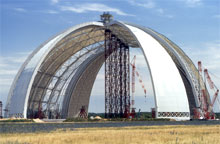

The down sides are – lots of moving pieces and the doors have to slide past each other (so do not seal well).
#Cargolifter hangar door hinge plus#
On the plus side, the doors can be opened onto only nine feet of building wall on each side of the opening (so for a 36 foot wide door, 54 feet of building wall would be required). The center two panels mount in the outer track, with one panel to each side of these, on the inner track. For a 36’ width opening, imagine four door panels, each nine feet wide. Taking things up a notch would be the use of double sliding door tracks. This poses some challenges, as a 36 foot width door, would require a 72 foot wall. In an ideal world the sliding hangar doors would fit across the building face, with no door projecting past a corner. Flying sliding doors present an extreme hazard to living creatures! And, what happens when a door or doors are left open, and the wind picks up? Not only is the wind speed picking up a concern, but there is a good chance the doors are going to be picked up, and deposited somewhere potentially uncomfortable. Besides the remote columns becoming magnets for planes and vehicles, they take up valuable space which might not be available to begin with. I would strongly discourage anyone from going this route. Most, if not all of us have seen older hangars with sliding doors which slide past the corners of the pole buildings and are mounted to headers supported by wood columns placed at a distance away from the building corners. An interior latch system should firmly lock the two sections in place at the middle, when closed. Properly designed, they should include a method of positive anchorage at the center, to the ground. Although still fairly large in width, split (also known as bi-parting) sliding doors might be a consideration.īi-parting sliding hangar doors are actually two independent doors, with an astragal to connect the two together when closed. As a minimum width door opening is probably 36, if not 40 feet in width, this rules out the practicality of a one piece door. Least prone to maintenance issues, as well as most secure, will be doors mounted on a single track. This means aluminum or steel framed doors are the only viable solutions. The vertical members do not have the strength to carry wind loads, and (unless the doors are very, very small) wood horizontals cannot carry the loads either. Let’s start the discussion with simple….just “plain old” sliding hangar doors, mounted on the outside of the hangar.įor starters – wood framed sliding doors are automatically excluded. I didn’t like sliding hangar doors as a design solution then, and I like them even less as an adult.

I grew up having to slide open hangar doors to get my Dad’s 182 Cessna in and out.


 0 kommentar(er)
0 kommentar(er)
